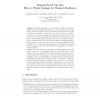35 search results - page 7 / 7 » Making Sense of Smart Card Security Certifications |
MOBICOM
1996
ACM
13 years 9 months ago
1996
ACM
Even as mobile computing and network computing are gaining momentum, Internet security is sharing the spotlight. Security and authentication on open networks is already a difficul...
KDD
2012
ACM
11 years 7 months ago
2012
ACM
With the wide deployment of smart card automated fare collection (SCAFC) systems, public transit agencies have been benefiting from huge volume of transit data, a kind of sequent...
JNW
2008
13 years 5 months ago
2008
As the Internet becoming popular, many sectors such as banking and other financial institutions are adopting e-services and improving their Internet services. However, the e-servic...
IACR
2011
12 years 4 months ago
2011
Abstract. Tampering attacks are cryptanalytic attacks on the implementation of cryptographic algorithms (e.g., smart cards), where an adversary introduces faults with the hope that...
ASIACRYPT
2003
Springer
13 years 10 months ago
2003
Springer
Provable security usually makes the assumption that a source of perfectly random and secret data is available. However, in practical applications, and especially when smart cards a...

